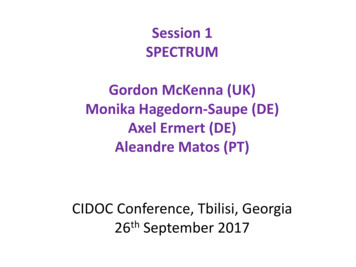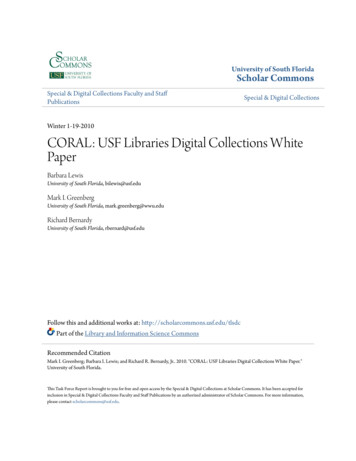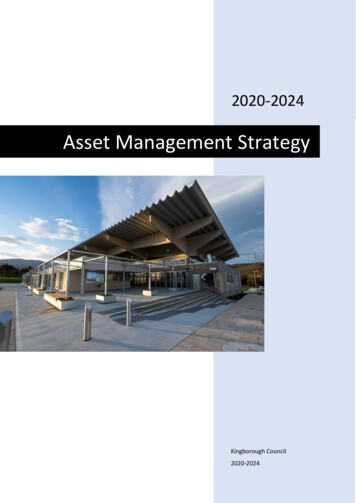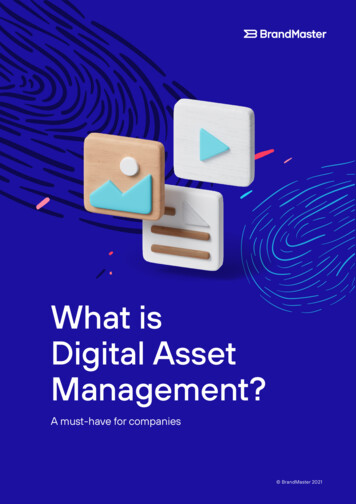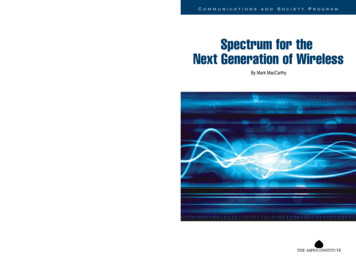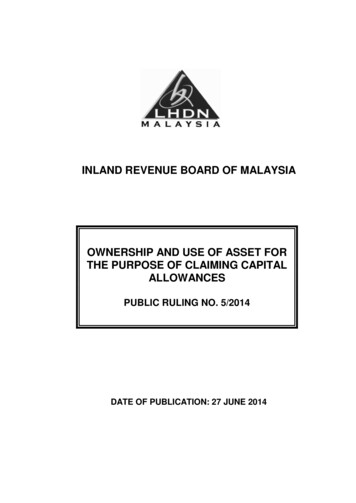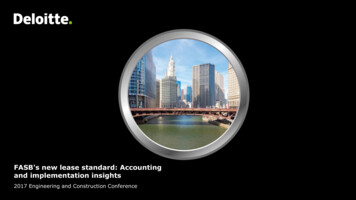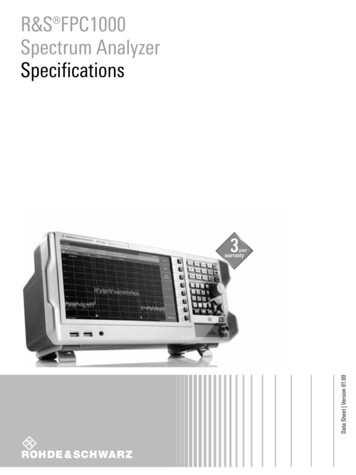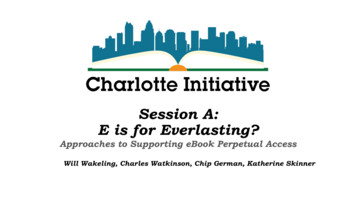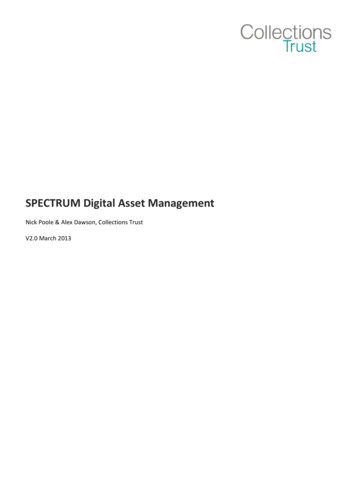
Transcription
SPECTRUM Digital Asset ManagementNick Poole & Alex Dawson, Collections TrustV2.0 March 2013
SPECTRUM is a Trademark of the Collections Trust,a registered company in England in Wales.The content of this publication is copyright theCollections Trust and published under a CreativeCommons CC-BY-NC license.The Collections Trust is a charitable organisationwhich champions collections and their positivecontribution to public life.The Collections Trust gratefully acknowledges thesupport of the Arts Council England (ACE) and themembers of the SPECTRUM Partners Scheme fortheir support in the development of this document.www.collectionstrust.org.ukMarch 2013
CONTENTSWelcome to SPECTRUM DAM . 4Strategic Collections Management. 5About this Guide . 6What is Digital Asset Management? . 7Benefits of Digital Asset Management for your Organisation. 9Creating a Digital Asset Management Strategy .10SPECTRUM Procedures & Digital Asset Management .13Digital Asset Management Policies .22Metadata for Museum Digital Asset Management .28Technical Options .32Models for DAMS Implementation .36Appendix 1: Strategic Collections Management Model .43Appendix 2: SPECTRUM Information Groups .44Appendix 3: Links and Resources .46
Welcome to SPECTRUM DAMWelcome to SPECTRUM Digital Asset Management. This document is intended as a companion to SPECTRUM, theinternational Collections Management standard which the Collections Trust develops with the support of and onbehalf of a global community of museums, galleries, libraries, archives and other cultural heritage organisations.The creation, management, publication and preservation of digital assets have become core business of culturalorganisations. Digital output, whether born-digital or digitised from analogue sources, forms an increasinglysignificant proportion of the heritage of future generations.The Collections Trust believes that in order to be sustainable the management of digital heritage must be broughtinto the same professional context as the management of tangible physical collections and the information andknowledge assets which connect them. The collections in the care of cultural heritage professionals include 5 keycomponents*:Physical CollectionsAdministrativeInformationDigital AssetsCollections-basedKnowledgeNarrative Information* Noting that these broad definitions can be subdivided into many different categories, such as documentaryheritage, oral history, collections of built environment and heritage sites (such as graves), non-digital recordings(such as tapes, dictabelt or negatives), citations associated with the collections (as separate collections in theirown right) and recordings of past exhibitions.This concept of integration of the management of physical and digital material and the administrative, narrativeand scholarly information which bring them to life is central to the principles set out in this document and in thecore SPECTRUM standard.The aim of this document is to set out a proposed methodology by which digital asset management can beintegrated alongside the existing curatorial and management functions of the organisation to ensure that they arewidely adopted and sustained as a core element of practice.4
This document provides information and guidance on the development of a Digital Asset Management Strategy(DAM Strategy), associated DAM Policies, the implementation of a Digital Asset Management System (DAMS) andthe integration of Digital Asset Management Workflows (DAM Workflows) alongside the existing SPECTRUMCollections Management processes.Strategic Collections ManagementThis document, along with the broader SPECTRUM standard, should be read in the context of the CollectionsTrust/BSI Code of Practice for Collections Management (BSI Publicly Available Specification 197:2009).The Code of Practice for Collections Management defines a vision of the management and use of collections thatis fundamentally connected to the mission and values of the organisation, and which is defined around supportingthe needs of its users.All decisions about the creation, acquisition, management, re-use, distribution and development of collections(whether physical or digital) must be driven by the central purpose of promoting access, proactively enablingengagement and supporting the organisation in delivering its public task.This user-centric approach to collections management must be underpinned by a commitment to ongoing review,evaluation and improvement if the organisation is to continue to promote the mutual aims of accountability,relevance and sustainability.A full description of the Strategic Collections Management Model is provided in the Appendix to this publication.5
About this GuideThe aim of this guide is to support cultural heritage organisations in understanding how to approach theintegration of Digital Asset Management (DAM) into their existing collections practice.This guide has been produced following consultation with the international SPECTRUM Community. It is intendedto be a work in progress and will be updated periodically to reflect changes in practice.The guide is intended to support you in working through the development of 5 elements of successful digital assetmanagement in your organisation: Considering why and how DAM can benefit your organisationDeveloping a DAM strategyIntegrating DAM alongside your existing SPECTRUM-based collections practicesDeveloping and communicating DAM Policies for your organisationProcuring and implementing a Digital Asset Management System (DAMS)This guide is not intended as a standalone guide to digital asset management and should be read in the context ofthe SPECTRUM standard and the Collections Trust/BSI Code of Practice for Collections Management.This guide is not a standard – it does not set out formal requirements, but instead presents suggestions andrecommendations for consideration. You should always seek expert advice and draw on the experience of yourpeers when undertaking the procurement or integration of a digital asset management into your organisation.6
What is Digital Asset Management?The purpose of this guide is not to provide a standalone definition of digital asset management (DAM). However,it is useful to provide a working definition of DAM in the context of a collecting organisation such as a museum,archive, library, gallery or private collection.The Canadian Heritage Information Network (CHIN) defines digital assets as1:“Digital materials created or owned by your institution.Digital assets exist in a variety of formats, and can include text, web, audio, video and image files.Digital images of objects in your collection are digital assets, as are logo image files, corporatePowerpoint presentations and any other digital resources created by your institution that generaterevenue or that provide valuable content to employees or clients.Digital assets may be used in many contexts, including sales, marketing, education, webdevelopment, collections management and digital preservation. Sometimes you will see the term'media asset' used to refer more narrowly to audio or video content.”In the broadest sense, DAM refers to the processes and practices involved in the creation, description, storage,discovery, re-use and preservation of digital assets.In the context of the Strategic Collections Management Model, your organisation’s approach to DAM mightinclude some or all of the following elements: A business case, or the identification of key drivers or success criteriaA content audit, or inventory of your existing digital assetsA DAM strategyPolicies and procedures for DAMThe procurement, implementation & maintenance of a Digital Asset Management System (DAMS)Staff training and change managementRecruitment of additional skilled/specialist staffAssociated policies for rights, user access control & persistent identificationA plan or strategy for Digital Preservation (including format transition planning)Policies for metadata, file-naming conventions and file formatsMappings of metadata schemata between inter-dependent/interoperable systemsIntegration of digital asset and collections management workflowsUpdating and/or upgrading of internal IT systemsContracting of external systems and capacity (such as cloud or offsite storage and backup)Policies on information security, resilience and access controlAs with all large-scale infrastructural developments for your organisation, the impetus to implement a DAMstrategy should derive from a clear business case, a clear understanding of the strategic context and a carefulanalysis of the impact of the change on the whole organisation.1Digital Assets and Museums, an Introduction, CHIN (http://www.pro.rcip-chin.gc.ca)7
In the same way that you should consider all functions and departments of the organisation as clients of thecollections and associated knowledge resources, DAM is an issue which cuts across the whole organisation. Theimplementation of a strategy and DAMS should be undertaken in the context of a clear understanding of theimpact and value for all activities across the organisation. It should also be aligned clearly to the strategicdirection of the organisation and the resources that are available to support it.The planning, implementation and subsequent maintenance and development of your DAM strategy and systemare classic change management processes – their success depends as much on cultivating clarity and supportwithin the organisation, and ensuring that people feel empowered to embed it into their working practice as itdoes on the selection of a particular system.In the long-term, the success of your DAM activity will depend on establishing a culture across your wholeorganisation which values the management, preservation and re-use of digital assets as a core aspect of yourwork alongside the equivalent management of your collections and the knowledge associated with them. Thisdepends on a clear change management strategy and the effective implementation of a phased rollout acrossyour organisation.8
Benefits of Digital Asset Management for your OrganisationImplementing DAM strategy, procedures and system in your organisation requires planning, coordinated effortand the investment of time and resources. It can also deliver significant benefits both in terms of the efficiency ofyour operations, the sustainability of your digital outputs and their impact and value for your users.Benefits of developing a DAM strategy for your organisation could include (prioritised for ease of reference):Primary Benefits Improved discovery of information, both internally and externallyProviding organisation-wide access to digital assets for all staff/departmentsSupporting more rapid approaches to innovation and prototyping new servicesPromoting collaboration between different organisational functionsImproved rights management within your organisationSecondary Benefits Promoting the sustainability, longevity and accessibility of your organisation’s digital outputs (includingcreated digital content)Reducing the opportunity costs arising from lost or inaccessible informationImproved visibility of value and impact of digital assetsImproved compliance with legal or statutory responsibilitiesAdditional Benefits Demonstrating the same commitment to the responsible acquisition and management of digital assets asfor your physical collections and associated knowledge assetsSupporting the training and professional development of your staffDemonstrating a commitment to long-term value for funders and investorsHelping your organisation to attract funding opportunities (EU funding, and international projects)Whatever your motivation in implementing a DAM strategy for your organisation, it is important to be clear about(and to share with your colleagues) the benefits which you are hoping to achieve.9
Creating a Digital Asset Management StrategySuccessfully implementing DAM in your organisation is not simply a question of choosing the right technology orcapturing the right digital formats. It is a change which affects your whole organisation and everyone in it.Rather than thinking of it in terms of ‘implementing DAM’, it is sometimes helpful to think about what it means tobecome an organisation which creates, collects, preserves and re-uses digital assets in much the same way as youcollect and provide access to your physical collections.There are implications in terms of cost, staffing, changes to your working practice and organisational culture. Theway you approach it will have an impact on the services you are able to offer your users and the extent to whichthese are scalable to take account of long-term changes in technology and behaviour.It is also important to recognise that the DAM needs of your organisation and users will be unique – you shouldalways guard against adopting a DAM strategy that has been developed for a different context or organisation.For this reason, tempting though it might be to rush straight in and obtain a digital asset management system foryour museum, archive, library or gallery, it is always a good idea to take the time first to understand some basicquestions: What are you hoping to achieve?How will it benefit your organisation?Who are the main people who need to be involved?Why are you doing it now?How will you ensure that your approach to DAM is viable in the medium to long-term?Knowing the answers to these questions will save a lot of time and reduce the risk of misunderstanding in thelong run.Managing Change in your OrganisationIt is beyond the scope of this publication to provide detailed advice on change management. However, it isimportant to bear in mind that the implementation of a DAM strategy in your organisation is a significant change,and that there are some simple principles which will help you manage this change and – perhaps moreimportantly – help your colleagues get behind what you are trying to achieve.Principle 1. Influence mattersNo matter how positive or constructive the changes you areproposing, they need the support and endorsement of the people inyour organisation who are in a position to facilitate them.This commonly includes one or more management or Board-levelchampions who are not only important in terms of their formal role,but who also carry personal credibility within the organisation. It issometimes also the case that additional influence is required fromoutside the Board to secure buy-in.10
Principle 2. Communication mattersEveryone that is potentially affected by the change (which in practiceis usually everyone in your organisation) needs to receive consistent,ongoing communications which clarify: Why the change needs to happen (WHY)What, precisely, you are proposing to do (WHAT)When the changes will happen (WHEN)How you propose to make them (HOW)You should never assume that just because you have told people whatyou are doing, this means that they have engaged with theimplications of the change. It needs to be stated and re-iteratedconsistently so that people have time to consider how it will affectthem.Principle 3. Peer-group mattersIn addition to reflecting on the change personally, the people it affectsneed to see others in their peer-group embrace the change and fit itinto their working practice.In practice, this means encouraging teams and departments in yourmuseum, archive, gallery or library to work together to ensure thatthey understand the change and its implications.Principle 4. Skills matterEven when people have acclimatised themselves to the change youare proposing, they will not accept it unless you ensure that they havethe knowledge, skills and support that they need to internalise it intotheir own practice.In practice, this means providing training, technical support, peergroup support and other forms of knowledge and skills-developmentto help people embrace the change.These principles are important when thinking about your DAM strategy because the integration of DAM into yourworking culture is likely to represent a significant change, and potentially a challenge for your colleagues.A measure of preparation before you begin will help save considerable effort, time and potentially money furtherdown the line!Where does your DAM Strategy fit?Once you are comfortable that you understand why you are implementing digital asset management in yourorganisation and the benefits you hope to achieve, it is worth spending a little time considering where your DAMstrategy fits within the overall strategic development of your organisation.11
In many cases, your organisation will already have a Strategic Plan, or will be part of a larger parent or governingbody which sets out strategic aims and objectives which affect you.It is always preferable for your DAM strategy to be integrated into or closely aligned with the mission, vision andstrategic objectives of your organisation. If it isn’t, you run the risk of the DAM strategy failing to deliver on yourorganisation’s ambitions, which will eventually result in it being marginalised and ignored.To be fully effective, your DAM strategy needs to be part of (and owned by the same people as) the overallstrategic management and direction of your organisation. This may also mean understanding how it fits into yourorganisation’s performance indicators, or its internal understanding of what constitutes success.This process of alignment can be critical in ensuring that the whole organisation understands how DAM deliversvalue for their work, not just in terms of collections and preservation, but also in terms of audience engagement,revenue-generation and strategic planning. Broadly, each department, team or function in the organisation needsto understand how DAM will help them achieve their objectives.Components of a Digital Asset Management StrategyOnce you have understood the key drivers for implementing DAM and how it fits alongside your existing strategicdevelopment it is time to start assembling your overall DAM strategy.DAM strategies come in all shapes and sizes, and there is no one-size-fits-all model which can be applied to everyorganisation. There are, however, a number of core elements which tend to feature in common across differentstrategies: Mission – clearly aligned to the mission and vision of the organisation Short, medium and long-term goals (eg. 1, 3 and 5 years) – aligned to the broader strategic objectives ofthe organisation Roles & responsibilities of the people who will be responsible for the strategy Characterisation of the user community/stakeholders of the outcomes of the strategy Success criteria and how they will be evidenced A schedule/period over which the strategy will be reviewed and refinedThe DAM strategy itself can be a relatively short document – what is important is that it captures a consensusabout the strategic purpose and intended outcomes of your DAM activity that is shared with the variousstakeholders within your organisation.The DAM strategy should act as a reference point throughout the planning, selection, implementation and longterm governance of both your DAMS and organisational support mechanisms such as training and ITdevelopment.The DAM strategy is also a key advocacy document, demonstrating to senior stakeholders how your DAM activityfeeds into and supports their broader objectives for the organisation.12
SPECTRUM Procedures & Digital Asset ManagementThe SPECTRUM standard provides a framework for the management and exchange of collections and theirassociated information, whether it is narrative, contextual, administrative or interpretive.SPECTRUM is used by a wide range of museums, libraries, archives and galleries worldwide to develop, reviewand improve their management processes in order to be more efficient and deliver greater impact for their endusers.As such, SPECTRUM provides a pre-existing foundation within which digital asset management can be integrated.An organisation that has been using SPECTRUM for any period of time is likely to have addressed some or all ofthe following (whether explicitly as documented policies, or implicitly in the form of custom, practice and workingculture):1.2.3.4.5.6.7.8.9.10.The integration of collections (and collecting activity) into their strategic planThe development of policies for collections managementThe implementation of procedures and workflows for collections managementThe training and development of staff in collections management practicesThe development of a culture of knowledge capture and managementThe deployment and use of systems for collections managementThe generation of performance or value indicators for their collecting activitiesThe integration of policies for collections development (accession and deaccession/disposal)Underlying business processes for the loan and transfer of collectionsThe integration of collections care and preservation into management processesIn other words, SPECTRUM promotes a culture of long-term strategic development, review and improvementbased on the following elements: formanceAt the same time, SPECTRUM encourages organisations to take an holistic and integrated view of the followingactivities as part of an overall continuum: Collections developmentCollections care & preservationLearning from and creating new knowledge about collectionsPromoting the use and re-use of collections and knowledgeThe use of SPECTRUM therefore provides a fertile basis for the integration of DAM as a specialised case ofCollections Management, both of which enable the museum, archive, library or gallery to achieve its strategicaims.13
SPECTRUM ProceduresThe SPECTRUM standard defines 21 procedures – essentially consistent, often repeated processes that arecommonly used in museums, galleries and other types of organisation for whom the management and use ofphysical collections is a primary responsibility.The SPECTRUM Procedures are:1.2.3.4.5.6.7.8.9.10.11.Pre-entryObject entryLoans InAcquisitionInventory controlLocation and movement controlTransportCataloguingObject condition checkingConservation and collections careRisk aluationAuditRights ManagementUse of collectionsObject exitLoans outLoss and damageDeaccession and disposalRetrospective documentationThe figure overleaf shows how the SPECTRUM procedures map to the core activities of collections development,collections care, knowledge generation, access and use.The purpose of SPECTRUM DAM is to show how digital asset management activities can be incorporated into anexisting organisational culture based on or compatible with SPECTRUM, so that they have a better chance ofachieving their maximum impact.14
Mapping DAM Activity to SPECTRUM ProceduresThe following table highlights the SPECTRUM Procedures in which digital asset management activity can be integrated alongside existing Collections Management practice:ProcedureSPECTRUM DefinitionDAM ActivityPre-entryThe management and documentation of the assessment ofpotential acquisitions before their arrival at the organisation.Increasingly, the acquisition of collections items will also beaccompanied by the acquisition of associated digital assets such asdata, images, scans and narrative information. Digital assets shouldbe managed and documented alongside potential acquisitionsbefore their arrival at the organisation.Object entryThe management and documentation of the receipt of objectsand associated information which are not currently part of thecollections.As with Pre-entry, new acquisitions are likely to be accompanied bydigital assets (alongside which, new digital surrogates such asphotographs and scans may be created during the acquisitionprocess).Any object which does not currently have an object numberassigned by the receiving organisation must be dealt withwithin this procedure.Loans inManaging and documenting the borrowing of objects for whichthe organisation is responsible for a specific period of time andfor a specified purpose, normally exhibition/display,but including research, conservation, education orphotography/publication.15All digital assets should be managed and documented alongside thereceipt of their physical counterparts. The digital assets should beassociated permanently with the object number of theircorresponding collection item through a scheme of persistentidentifiers.Loan objects will frequently be accompanied by digital assetsincluding data, PDF, images and narrative information. These digitalassets will need to be incorporated into the DAMS along with theirassociated context as part of a loan and their intended use (forexample, as part of an exhibition, marketing campaign, mobile appor website).
AcquisitionDocumenting and managing the addition of objects andassociated information to the collections of the organisationand their possible accession to the permanent collections.To an extent, the Acquisition process already integrates the captureand management of information content associated with thecollection item. At the same time as the material object is formallyaccessioned into the permanent collection, all associated digitalassets must be accessioned into the DAMS.Due consideration should be given when acquiring digital assets totheir fit with the organisation’s Acquisition and Disposal Policy, andto ensuring that they are catalogued sufficiently to support theirfuture discovery & re-use.Inventory controlThe maintenance of up-to-date information accounting for andlocating all objects for which the organisation has a legalresponsibility.This may include objects on loan, un-accessionedor previously undocumented items, temporarily depositedobjects and support collections.Location and movementcontrolThe documentation and management of informationconcerning the current and past locations of all objects orgroups of objects in the organisation’s care to ensure theorganisation can locate any object at any time.A location is a specific place where an object or group of objectsis stored or displayed.16Digital assets must be counted as assets of the organisation in thesame sense as the physical collections items. The DAMS should serveas a central inventory of digital assets belonging to the organisationin the same context as inventory-level records in the CollectionsManagement System.Ideally, the DAMS should fulfil this inventory function for all digitalassets created, owned, acquired, managed or used across theorganisation. In practice, some forms of digital asset may fall outsidethe scope of collecting activity and may be stored and managedlocally.In the sense that the purpose of the SPECTRUM Procedure is topromote the recoverability of the collection items, the equivalentDAMS activity must ensure that the organisation is able to retrieveassociated digital assets as efficiently as possible.
TransportThe management and documentation of the transport ofobjects for which the organisation is partially or fullyresponsible.Digital assets may be created as a result of the transport process (forexample scanned waybills, customs clearance forms, transport plansetc). Where digital assets are sent or transferred (for example, byemail, cloud storage or FTP service), the organisation should ensureadequate management and documentation of these processes bothto promote accountability and to mitigate the risk of infringement ormisuse.CataloguingThe compilation and maintenance of key information, formallyidentifying and describing objects. It may include informationconcerning the provenance of objects and also collectionsmanagement documentation e.g. details of acquisition,conservation, exhibition and loan history, and location history.The cataloguing of digital assets is of equal importance as thecataloguing of physical collection items. Where possible, the DAMSand associated policies and practices should support the capturingof information about the provenance, rights, usage, format andpreservation requirements of the associated digital assets.It need not bring together in one location everythingknown about an object, but should provide cross-references toany other relevant information source known to theorganisation.The cataloguing of digital assets ought equally to p
This document provides information and guidance on the development of a Digital Asset Management Strategy (DAM Strategy), associated DAM Policies, the implementation of a Digital Asset Management System (DAMS) and the integration of Digital Asset Management Workflows (DAM Workflows) alongside the existing SPECTRUM Collections Management processes.
